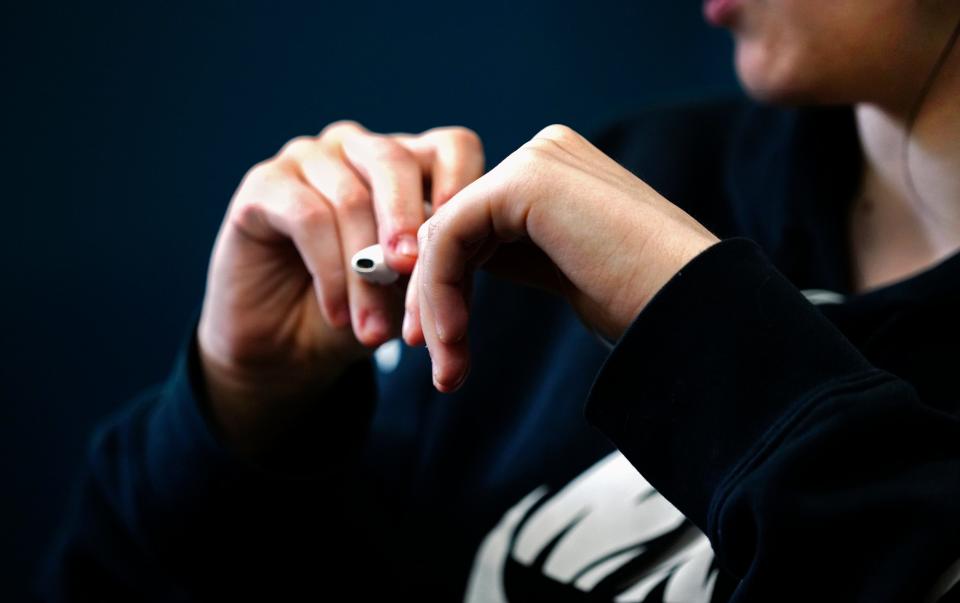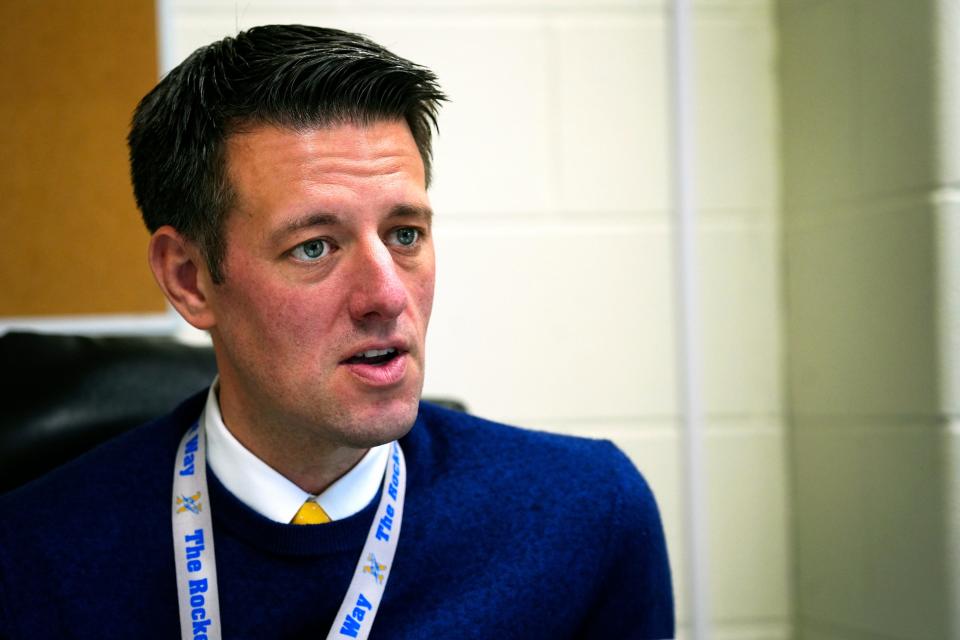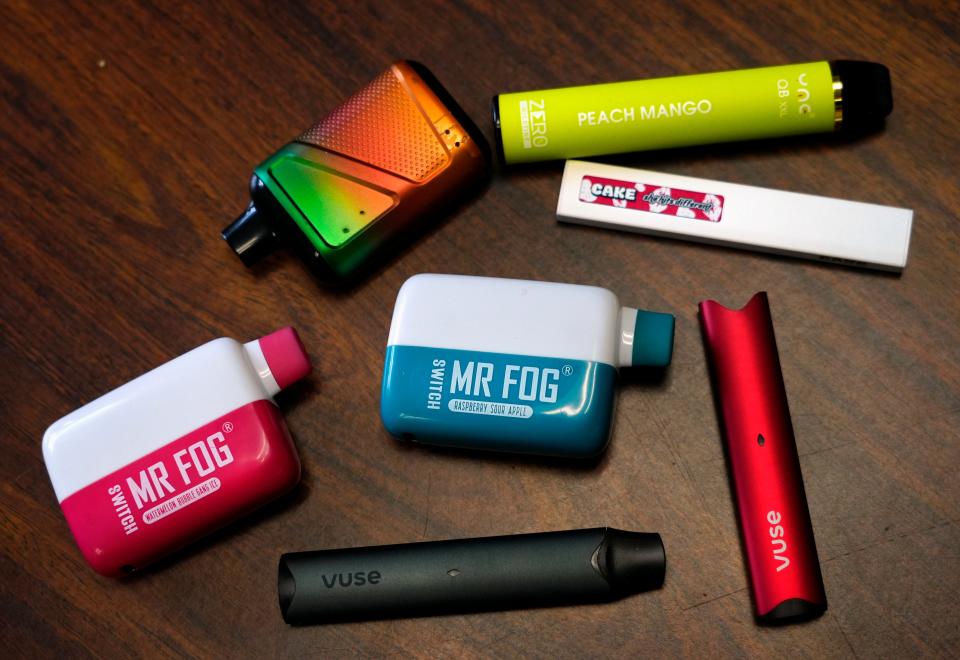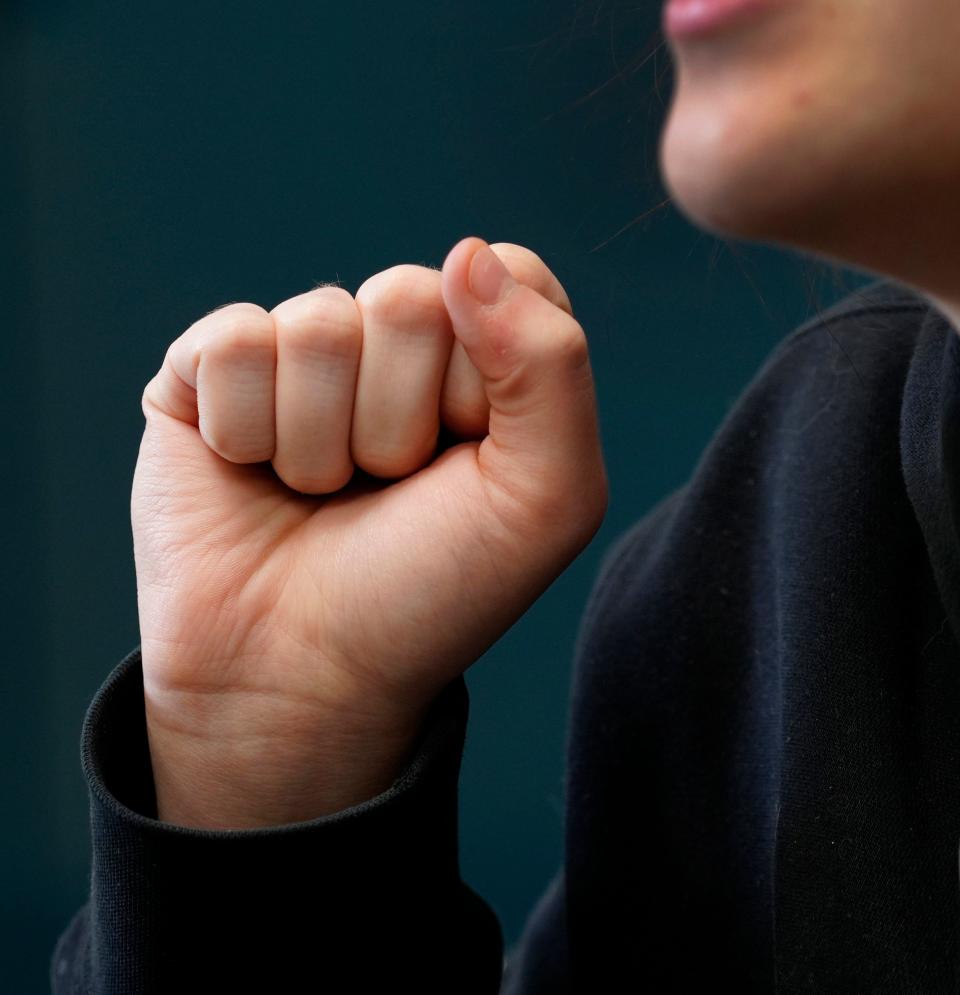'Found unconscious on the bathroom floor': Schools struggle to fight youth vaping crisis
For every puff of vape she inhales, 17-year-old MJ says she is rewarded one minute of relief. The anxiety that consumes her on a daily basis evaporates in that one minute, replaced by a blue raspberry haze she has grown dependent on.
She walks through her school hallways in this haze, though she knows vaping is bad for her health. Four years into inhaling vape juice, she's living with the consequences. She can't run for more than 10 seconds without having trouble breathing. There's a feeling in her lungs, she says, an intense squeezing sensation after she vapes. She gets migraines. Her throat is always dry. She's lost weight. She suffers from insomnia and a loss of appetite.

And those feelings of anxiety and depression come back after the 60 seconds are up. So she'll take another hit. And another.
"I crave it," she says.
MJ, who The Enquirer is not naming to protect her privacy, is one of hundreds of kids who were caught vaping on school property last year in the Cincinnati region.
Vaping is a problem everywhere: in city schools, in the suburbs and in rural towns, an Enquirer analysis of disciplinary records from districts across the region shows. Children and teens have easy access to vaping products and get hooked on the nicotine or marijuana they contain. And they bring them to school, where educators have become the vape police and are trying new ways to help kids quit vaping.
While most incidents occurred on middle and high school campuses, disciplinary records show kids in elementary schools − second graders, even − vape at school, too. In extreme cases, high schoolers were too high off their vapes to talk with the educators who caught them.
[ The Enquirer is making this special report on the youth vaping crisis free as a public service. Support local journalism with a subscription. ]
Those records don't come close to showing how prevalent vaping is among students, said Ben Brown, varsity football assistant coach and youth service center coordinator for Cooper High School in Northern Kentucky. Brown guesses schools only catch one-third of the kids who actually vape because so many of them do so discreetly through products that look like flash drives or ballpoint pens.
"I think it goes to your AP kids, I think it goes to your honors kids, I think it goes to the kids who are playing sports. I think it touches every realm of education," Brown said. "It's just, some (kids) get caught. Some don't."
$60K retreats and a metal detector: How one family fought a vape addiction
Why do kids vape?
Clermont Northeastern High School, which serves nearly 400 students near Owensville, about 20 miles east of Cincinnati, had 33 reports of vaping incidents last school year. Half of them took place in a school restroom, including when MJ got in trouble. Other students were found vaping or in possession of a vape product in the cafeteria, classrooms, the gym, the parking lot and school hallways.
At least five of those reports noted the student was caught because they posted photos or videos of themselves vaping at school to social media. Twelve mentioned the use of marijuana or THC, the cannabis compound that causes the "high" felt with use.
MJ said she got hooked in middle school. She was 13 when she was peer pressured into trying a Juul e-cigarette and was addicted within three months of taking her first hit. Juul Labs Inc.'s products were banned by the U.S. Food and Drug Administration in 2022. The company settled lawsuits in April with several states over allegations that the brand marketed to underage users.
For years MJ funded her addiction with the allowance money her mom gave her for doing chores. Her older sister, cousins and ex-boyfriend purchased vapes for her with the cash. Now she has a job and spends $60 per month on vapes. MJ needs one vape for every two weeks.
It's the flavor she craves more than the nicotine, she said. Her personal favorite is Mr. Fog's blue raspberry cherry ice. When she doesn't have a vape on hand she gets "angry and irritable."
"I don't think it's fun," she said. "Actually, there's been times where vaping has caused my anxiety attacks. It can cause anxiety and depression, too, it doesn't just relieve it."
It's hard to say how many of the region's kids are addicted to vaping. But the number of kids caught vaping at school is staggering: There were more than 1,000 reports of students vaping in school last year between two districts alone, Cincinnati Public Schools and Boone County Schools. The records were full of notes about other behavior issues from the kids who vaped and the lengths those students went to try to hide their contraband.
Students hid their vapes in shirt sleeves, boots, pants and bras. One student who blew smoke from his mouth during class said it was a friend's inhaler when initially questioned, then later admitted it was a vape he stole from his father. In another incident, a student flushed substances down a school toilet.
A CPS fourth-grader who hid the vape he was smoking in his sock said he got it from home and was "copying off of his brother," the report reads.
Another student, a sixth-grader, took a vape from the side table in her mother's bedroom and used it in the school bathroom.

A sophomore passed out and "appeared to be high" after throwing his cell phone toward the front of the classroom, nearly hitting his teacher in the head. According to the report, he had a nicotine vape and a weed vape on him.
"He is unable to write an incident report. He is barely able to sit up in a chair," the report concludes.
And the report for a ninth-grader at CPS is just one line:
"Drug possession; found unconscious on bathroom floor; called 911/ was vaping."
Vaping health risks: From their legs to their brains, unexpected ways vaping hurts kids
School programs aim to prevent, not punish, vaping habits
TJ Glassmeyer, former principal at Clermont Northeastern High School, said vaping is by far the biggest behavior issue among teens.
And vaping doesn't just impact the kids who smoke. Brown, in Northern Kentucky, said the vaping crisis influences the daily schedules of non-smoking students, too.

"A lot of times kids will just avoid the bathroom or they'll have to go during class time," he said, because during passing periods there are kids vaping in the restrooms.
What are vapes? What's in them? Everything you need to know about e-cigarettes
Most kids addicted to vaping want to stop, said interventionist Jennifer Hoffman. She's a nurse who supports students through Talbert House Prevention Services.
She, Brown and Glassmeyer subscribe to the same philosophy: Disciplining kids addicted to vaping won't solve anything.
"When kids are at home, they tend to use more. Vape more, use THC more. And sometimes kids just want to be home," Hoffman said. So they'll get suspended so that they can stay home all day and vape.
That's why some local districts are pivoting from suspensions and expulsions to diversion, prevention and even treatment programs for kids caught vaping at school.
The Talbert House program started in Clinton County at the end of the 2022 school year and expanded to Warren County this spring. It's a tiered system of interventions. First-time offenders meet for two 45-minute sessions during the school day. Students caught vaping a second time go for four sessions and students caught for a third time go for six sessions. Students caught with a THC vape need to complete six sessions in the program even if it is their first offense.

In Clinton County, the program is starting a new fourth tier that includes access to a therapist, with no cost to the school or students and families. Since nicotine patches and lozenges are not approved by the FDA for anyone under the age of 18, children need to consult a doctor first and get a prescription to use them. This program will give those kids access to professionals that can help with that and put them on their path to recovery, Hoffman said.
But for the first three tiers, which Hoffman runs in some Warren County K-12 schools, kids learn healthy coping strategies to combat anxiety and other triggers so they can get through their school day without vaping. A lot of those kids share some of the same patterns. They go to the bathroom a lot to vape, Hoffman said. They have sporadic attendance and slipping grades.
Some of her students are resistant to the program. But she thinks about half or more of the kids who complete the program, at any tier, actually quit smoking. Others who have been vaping for several years probably need more hands-on help from an addiction treatment program.
It's about building relationships, she said. Some of her kids refer their friends, who may also be addicted, to Hoffman for guidance.
"These are students who are asking for help. They want the chance to change," she said.
But not all of them think they can.

When MJ was caught taking a hit off a friend's vape in the girl's restroom last year, she wasn't suspended. Instead, MJ became one of the first students to try the school's new vape diversion program, through a partnership with Mercy Health, which meets twice a week after school for lessons on the dangers of vaping and 30 minutes of exercise.
She went. The program didn't change her mind about vaping, though.
"I enjoy the relieving feeling, even though I know it's probably hurting me. And I know it can really affect me later on," MJ said, after completing the six-week program. "I just, I'm not really worried about it, you know? My little motto that I say is, 'Everybody's gonna die somehow.' So if that's how I die, it's how I die. You know?"
From the editor: Why The Enquirer spent 6 months investigating teen vaping
Schools ask parents, local businesses, law enforcement for help
Hoffman went into a vape shop − which she does often as part of her work − near Kings High School recently and watched a high school student make a purchase without the cashier checking the girl's ID. The shop is less than a mile from the school, within walking distance, and situated between a Dairy Queen, Chipotle and Jimmy John's where students often go for lunch or after school.
"It's frustrating. Because, you know, we're really trying to help these kids who really want help and then another vape shop comes up and it happens to be, you know, in the path of how you exit the high school to get to the highway. And it just happens to be by the local ice cream shop," she said. "It's very sad."
Hoffman said the shop she was in recently had vapes branded with superheroes and other cartoons. The candy-like flavors are also there to entice preteens and teens. And some products, like the High Light Office 4 e-cigarette, look like highlighter markers; kids can sneak them into school without much notice.
Vaping is "a community problem," Glassmeyer said. He knows it will take more than a diversion program to combat the crisis, "but at least it's a first step in that direction."
He said he'd be happy if the school got one student to stop vaping, "if we were able to break that cycle of addiction with even one kid."
MJ said she doesn't think anyone can talk her into quitting, but she hopes she will stop vaping eventually. She needs to want it for herself.
"When I was younger I wanted to be a marine biologist. But I don't even know if I could do that now," she said, since she can't hold her breath for long enough to be underwater. "I mean, I could, if I stopped. But it's gonna take a lot."
If MJ could give advice to younger kids, she would tell them to never start vaping.
"It ruins you."
Read all the stories in this special report here.
This project was underwritten, in part, by Interact for Health. Underwriters do not determine, change or restrict content.

This article originally appeared on Cincinnati Enquirer: Vaping in school: Records show use is widespread, schools try to help

